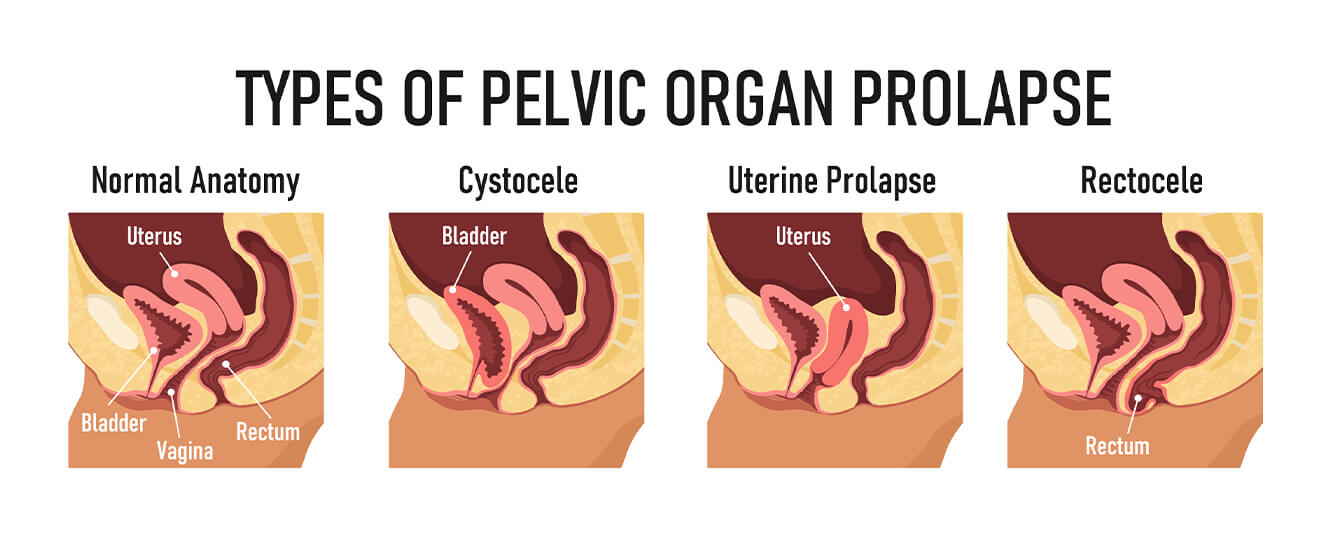Pelvic Organ Prolapse Treatment in South Florida
Pelvic Organ Prolapse is a type of pelvic floor disorder where the muscles and tissues supporting the pelvic organs (including the uterus, cervix, vagina, bladder, or rectum) weaken or become damaged and can no longer support the pelvic organs.
What are the symptoms of Pelvic Organ Prolapse?
Here are the most common symptoms of Pelvic Organ Prolapse:
- Feeling like something is falling out of the vagina
- Pressure against the vaginal wall
- Urinary incontinence or urgency
- Fullness in the lower abdomen and genitals
- Pain or discomfort during sexual intercourse
- Backache
- Feeling a pull or stretch in the groin

How is Pelvic Organ Prolapse diagnosed?
Pelvic Organ Prolapse is generally diagnosed during a routine pelvic exam. Additional tests, such as an ultrasound, MRI, CT scan or an intravenous pyelography (urinary tract x-ray), may be initiated based on the physical exam to make the final diagnosis in advanced cases.

How is Pelvic Organ Prolapse treated?
Your doctor will create a personalized treatment plan based on the severity of your symptoms and your quality of life.
For mild symptoms, there are lifestyle changes and non-surgical treatment options which may sufficiently
improve your pelvic muscle tone and decrease your discomfort. For more severe symptoms, there are a number of surgical options available.
Non-Surgical Treatment Options:
Lifestyle Changes: Diet and weight loss are effective lifestyle measures in treating pelvic organ prolapse. The addition of fiber to your diet can decrease constipation, a known precursor to prolapse problems. By reducing abdominal fat, you can also decrease the pressure on your pelvic floor, thereby minimizing symptoms.
Kegel exercises: Kegel exercises are recommended to strengthen the muscles around the opening of the vagina, rectum and urethra.
Biofeedback therapy: Long-term strengthening of your pelvic muscles using biofeedback to control the strength and placement of the muscle contraction has been found to successfully remediate certain symptoms of Pelvic Organ Prolapse.
Pessary: A pessary is a silicone device placed in your vagina that helps hold your pelvic organs in place and relieve the discomfort.
Surgical Treatment Options:
Our doctors have extensive experience with minimally-invasive surgical procedures, which often results in fewer noticeable scars, quicker recovery times and a shorter hospital stay.
Repair of Weakened Pelvic Floor Tissues: Laparoscopic reconstructive surgery can repair the pelvic floor and return the pelvic organs to their original position.
Hysterectomy: A hysterectomy may be the treatment of choice for women who have a prolapsed uterus and are not planning to have additional children. Laparoscopic or robotic surgery is generally performed when possible.
What are the risk factors for Pelvic Organ Prolapse?
The most common causes of Pelvic Organ Prolapse are pregnancy, labor, and delivery. Other risk factors include anything that puts pressure on your pelvic organs, including:
- Constipation
- Genetic tendency for weak connective tissue
- Obesity
- Persistent cough
- Pelvic tumors
- Prolonged and heavy lifting
Pelvic Organ Prolapse is not necessarily preventable, but it is treatable.
Pelvic Organ Prolapse is caused primarily by pregnancy, labor, and delivery. However, you can reduce your risk by choosing a diet high in fiber, avoiding smoking, and maintaining a healthy weight.
Our doctors at The Center for Gynecologic Oncology specialize in Pelvic Organ Prolapse and other pelvic floor disorders. As POP specialists, we understand how complicated and uncomfortable it can be to communicate symptoms and discuss solutions. Our goal is to facilitate the conversation, offer you the most up-to-date treatments, and encourage the best possible outcomes.


